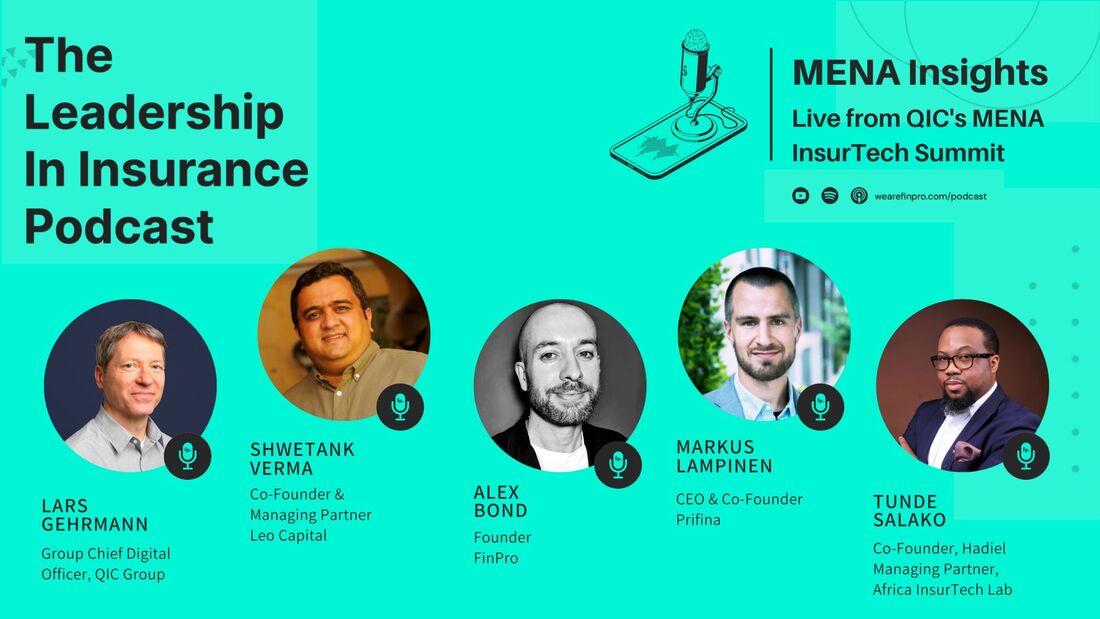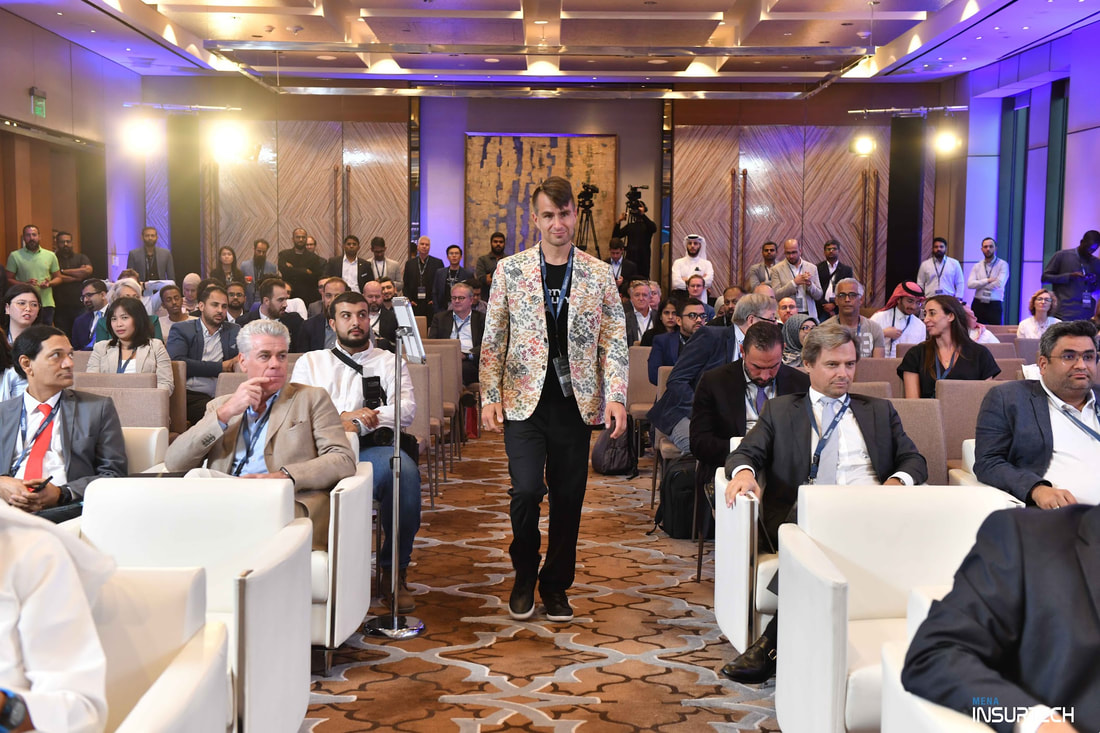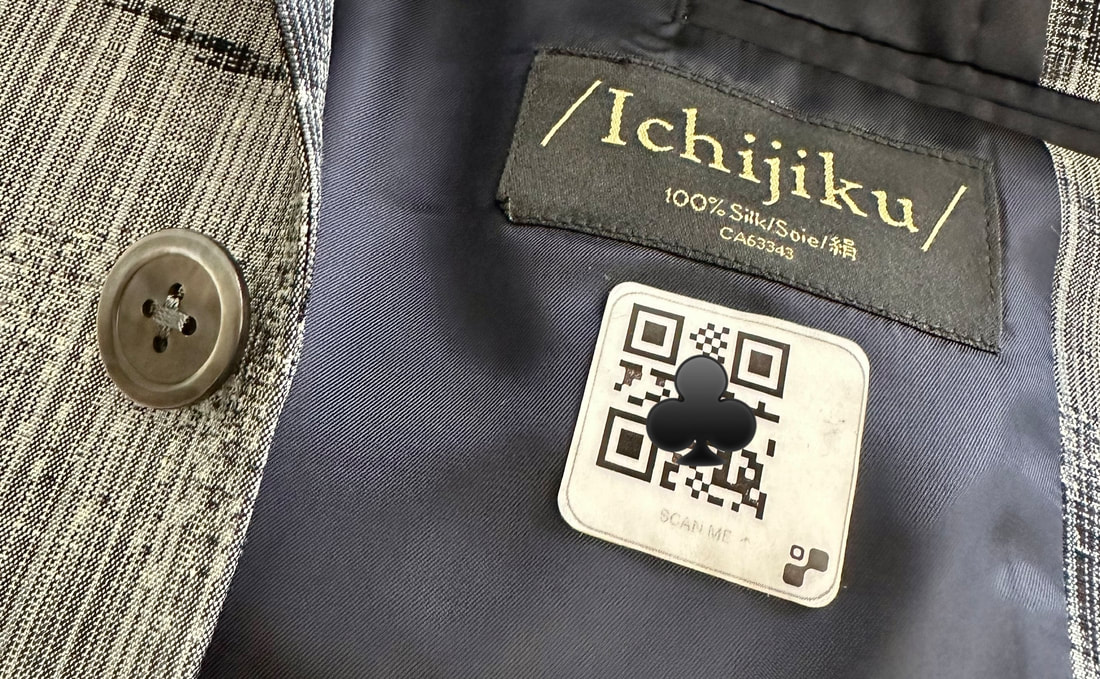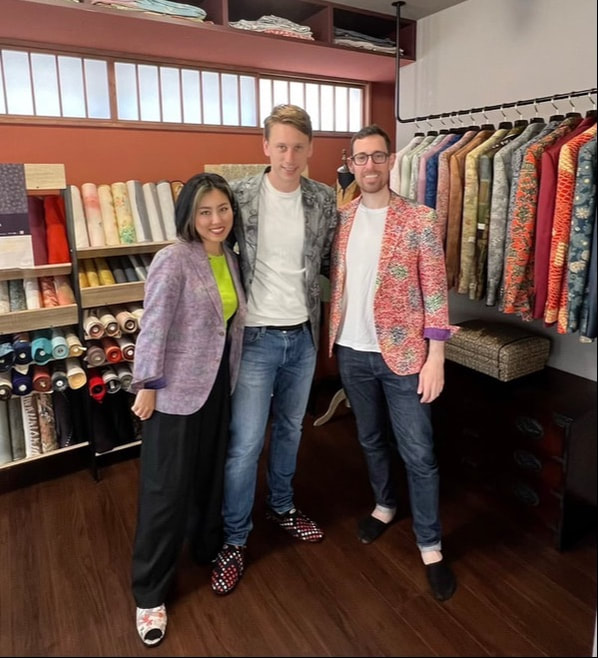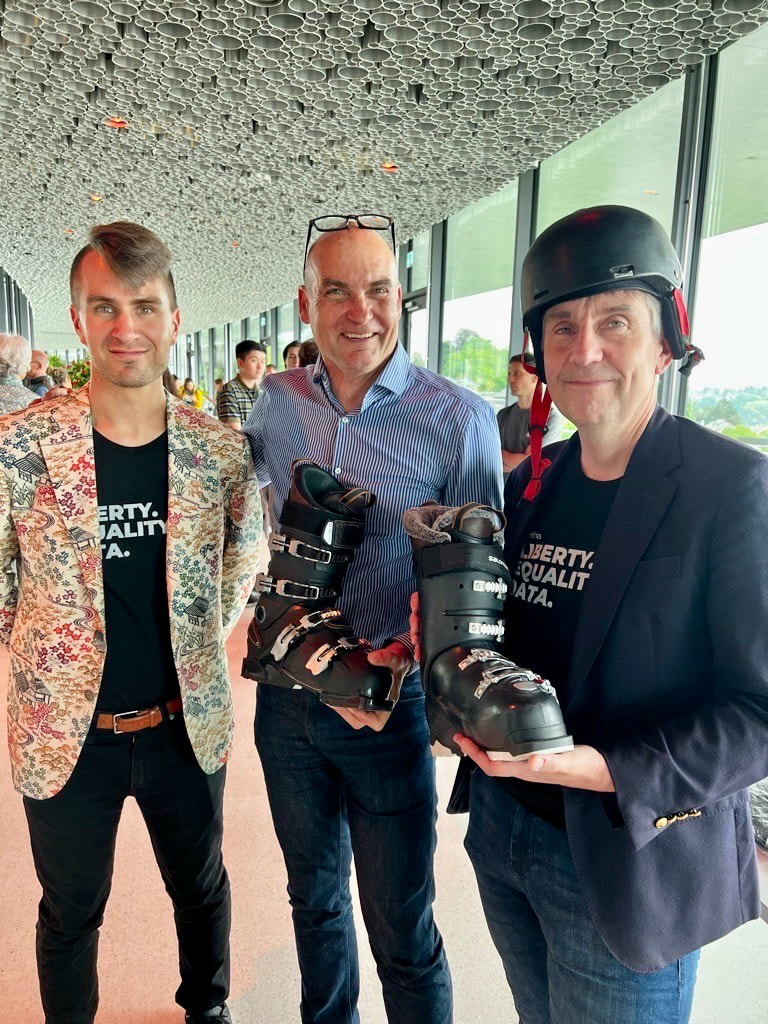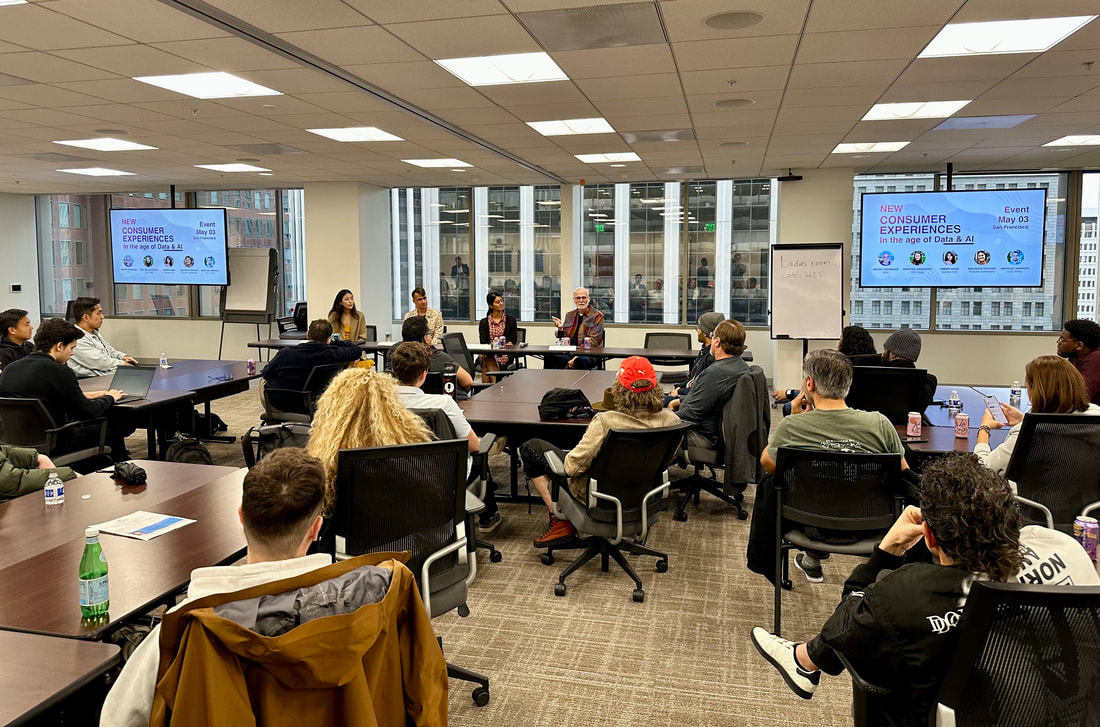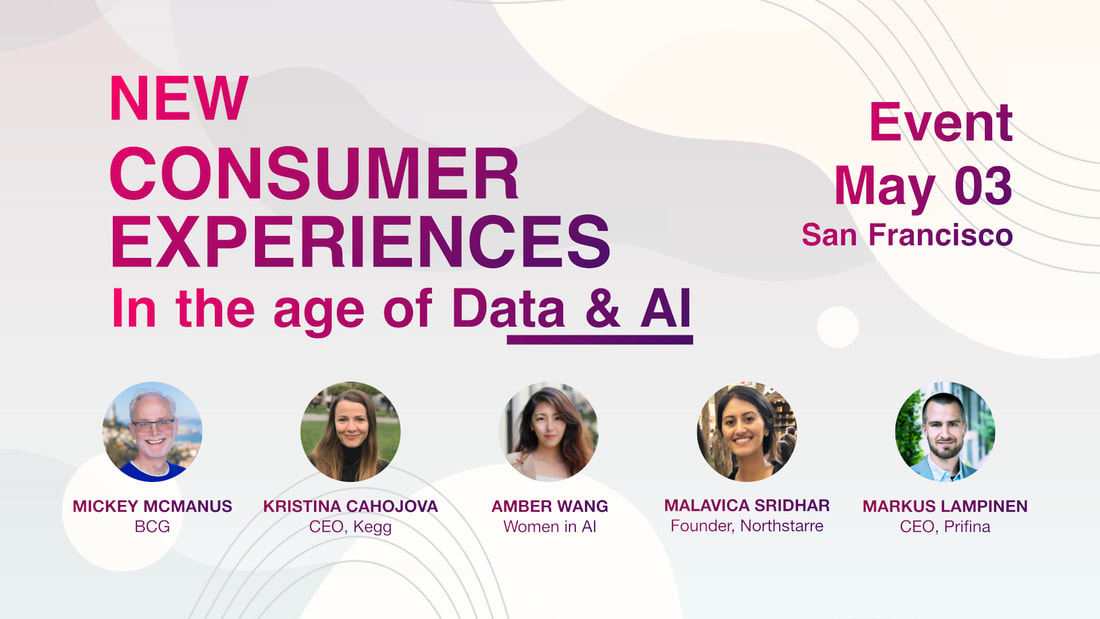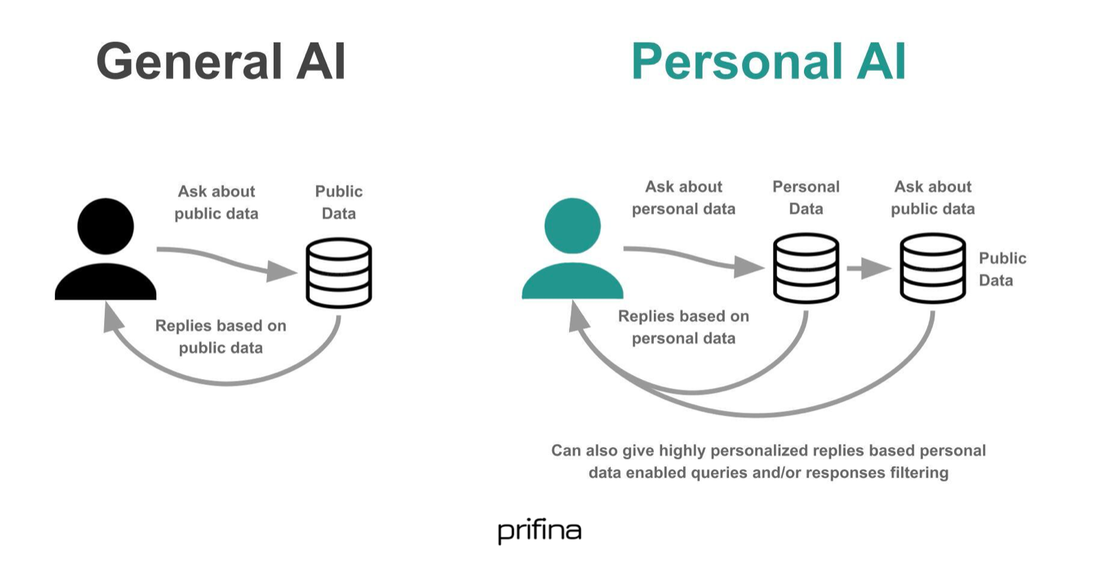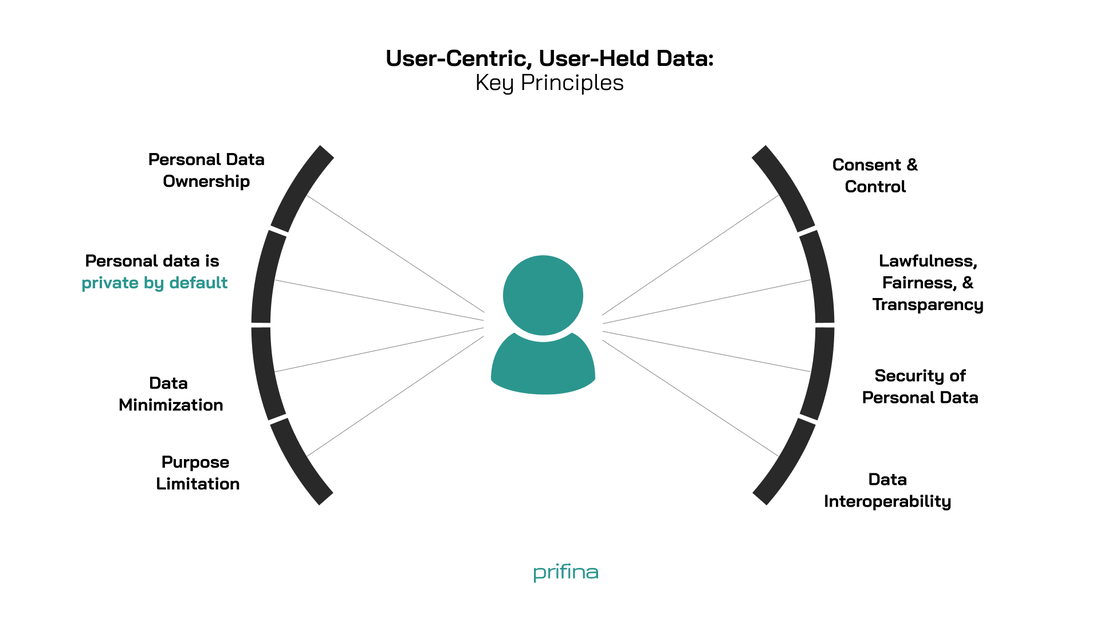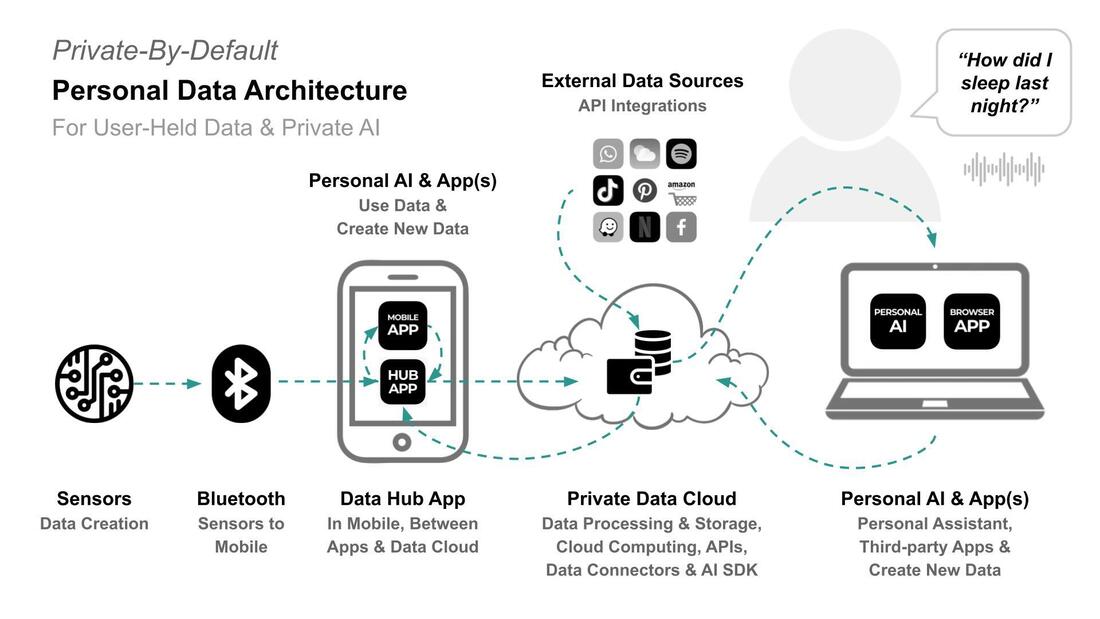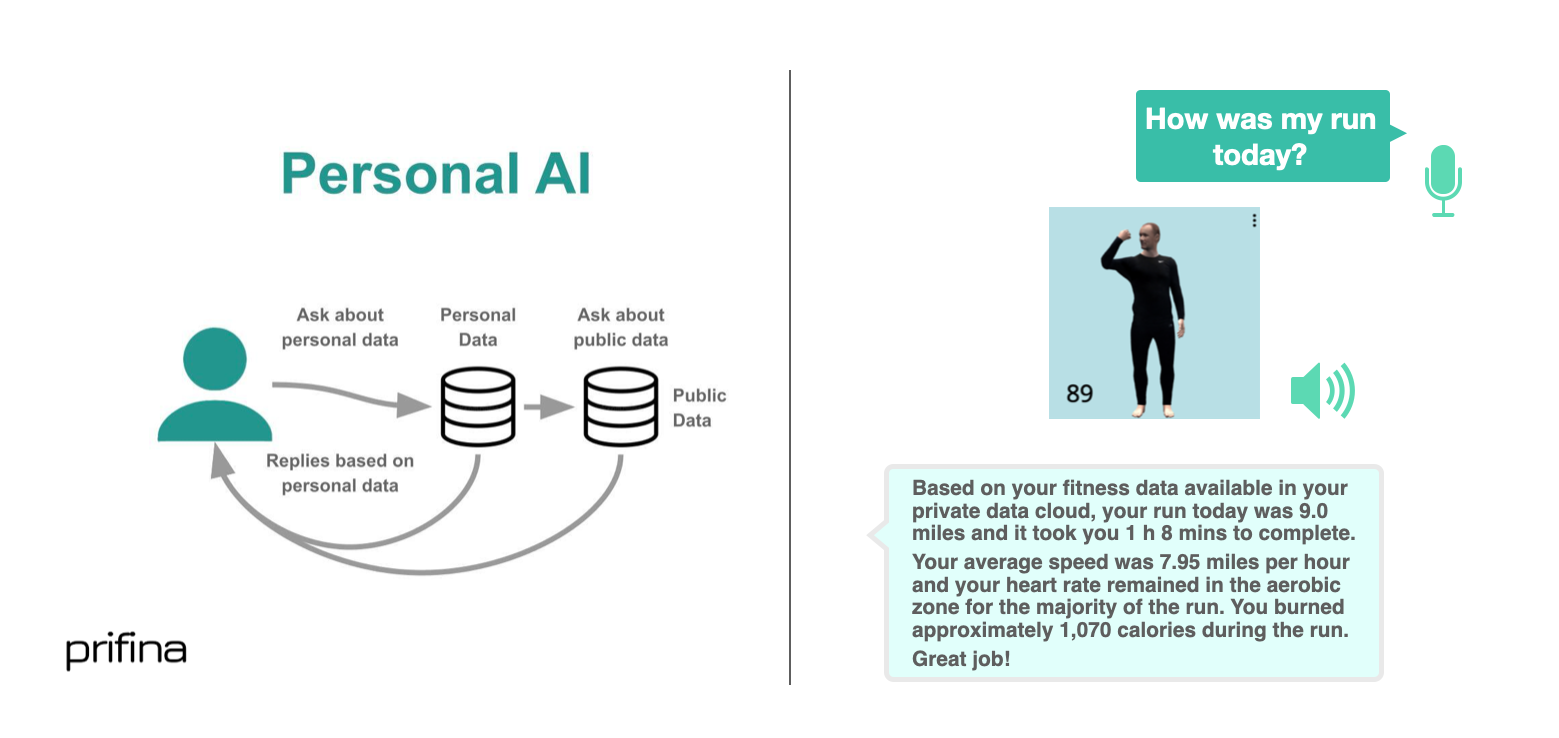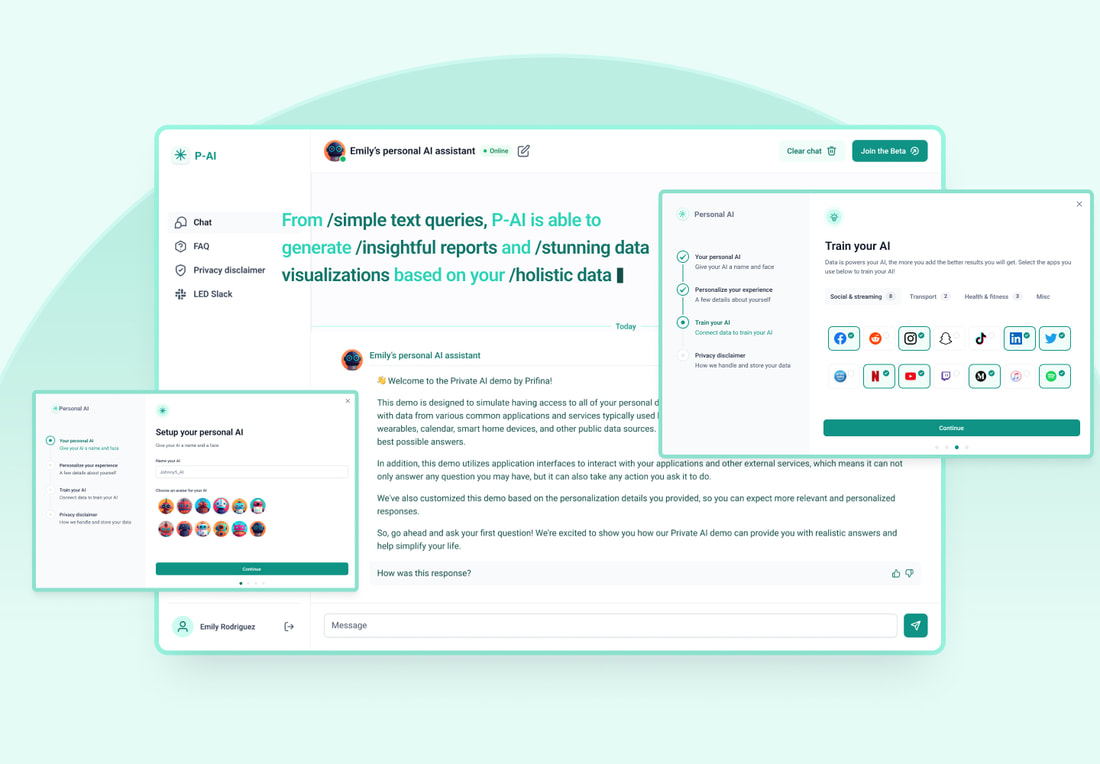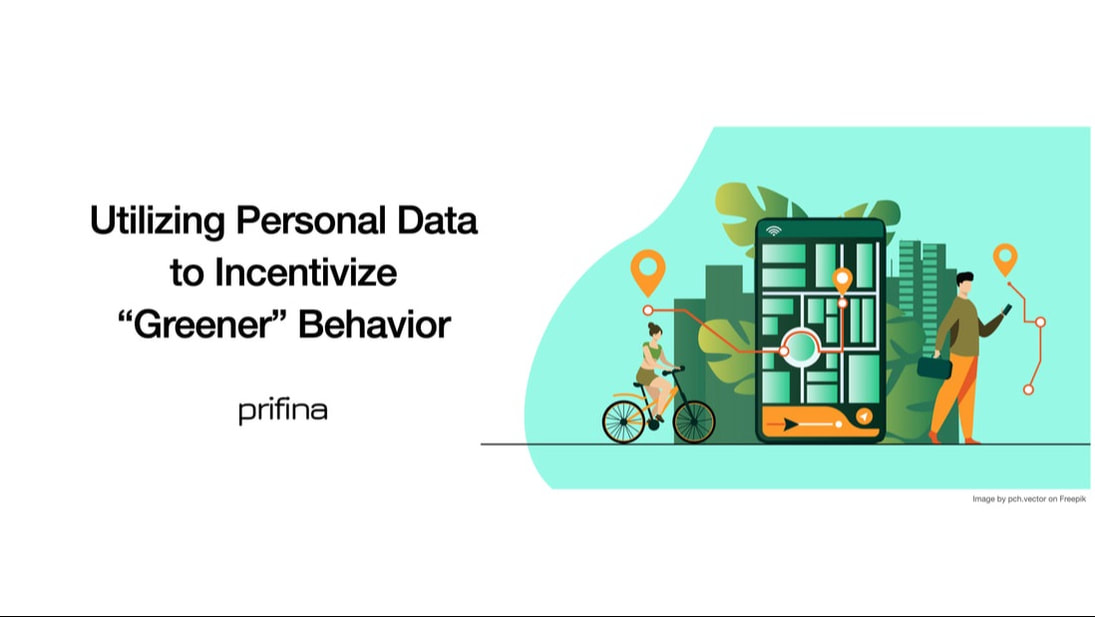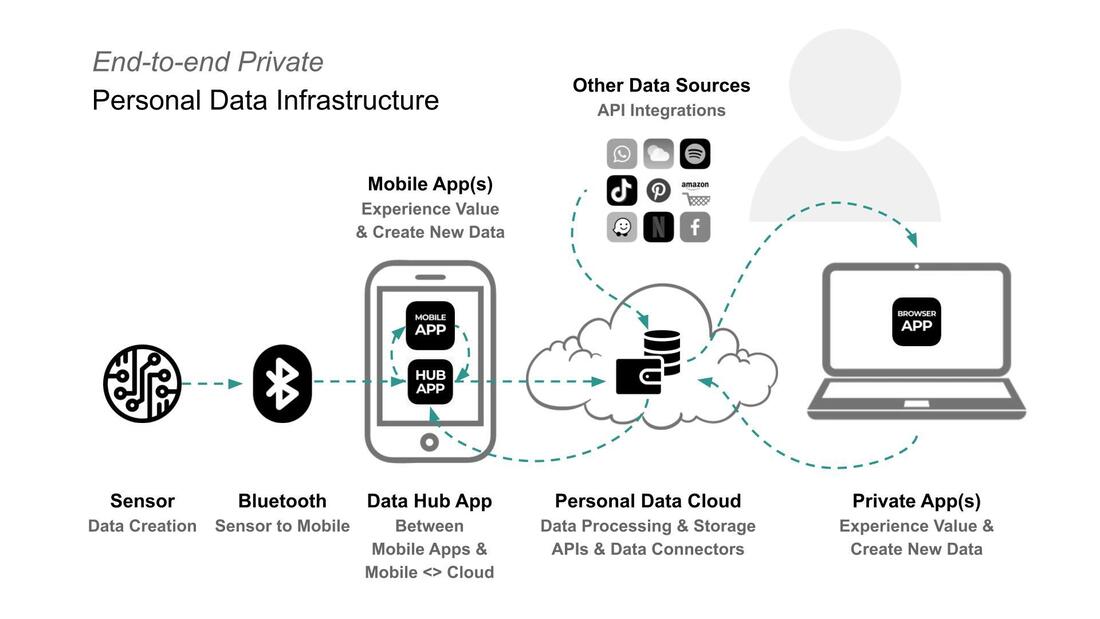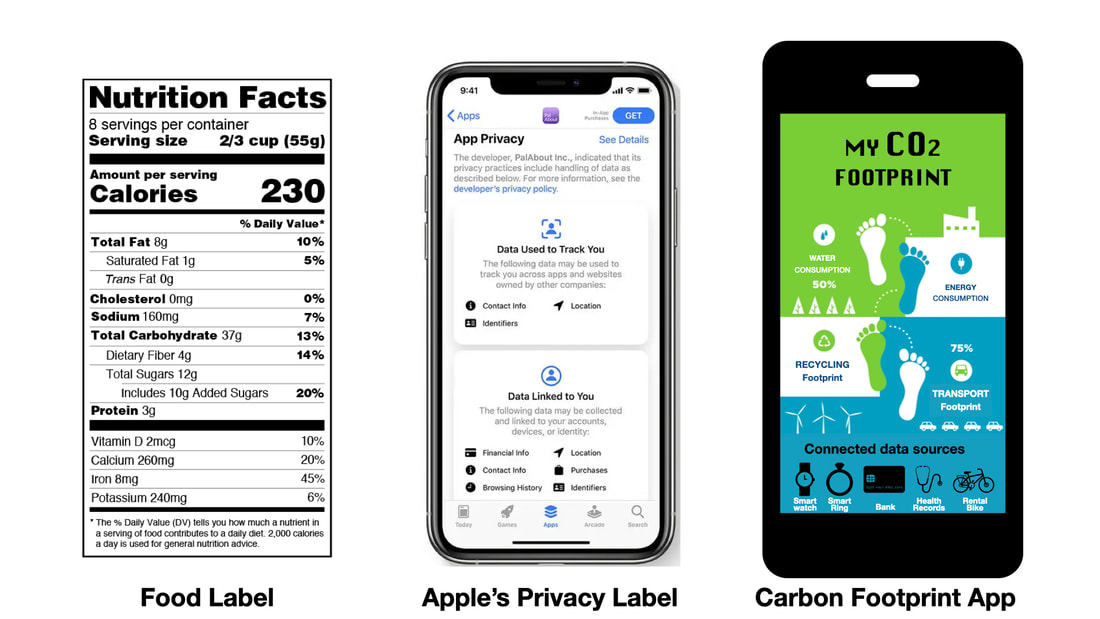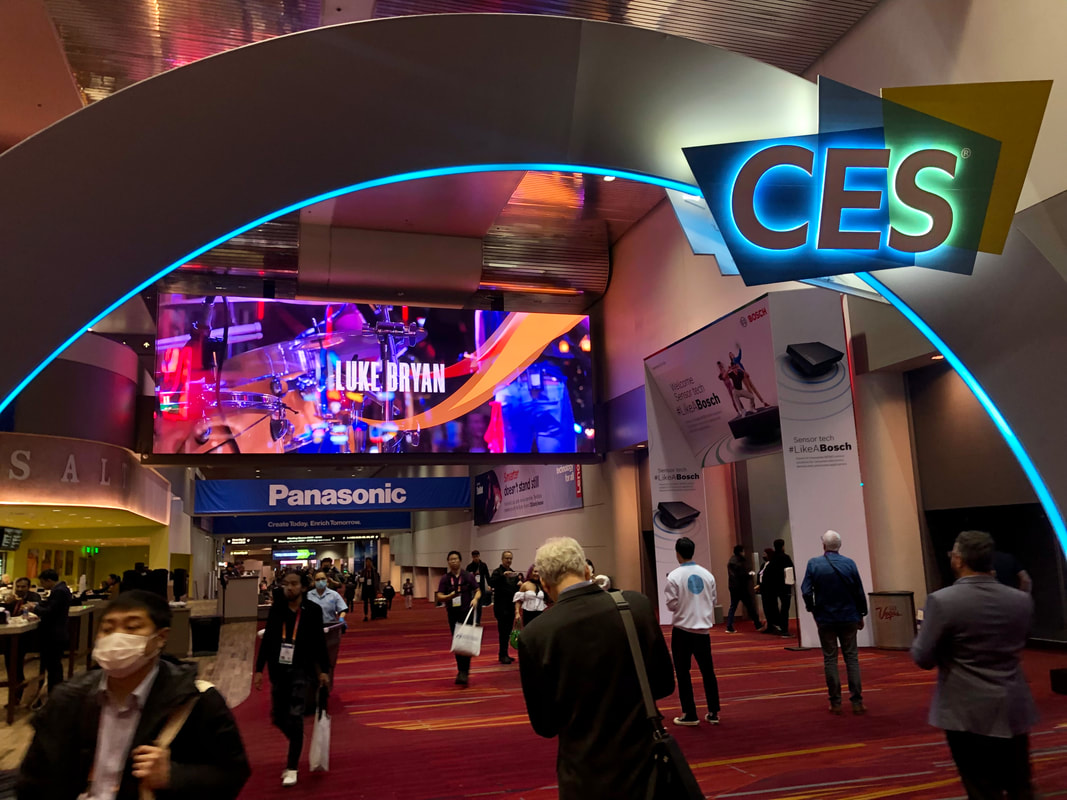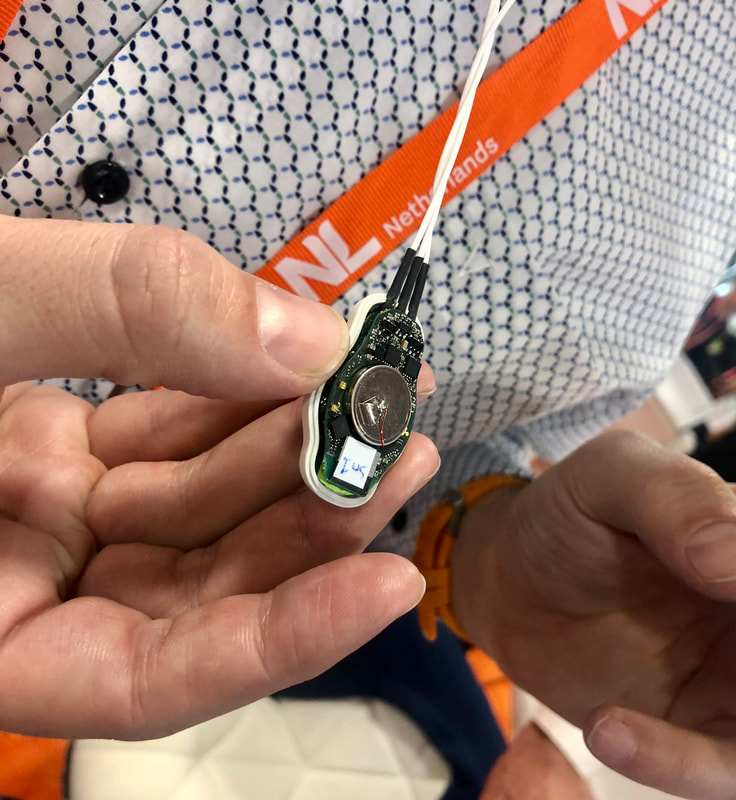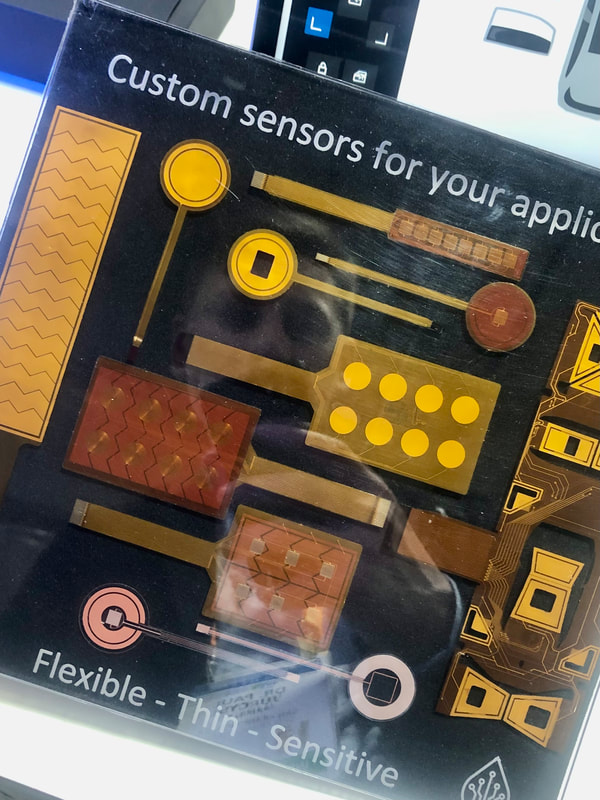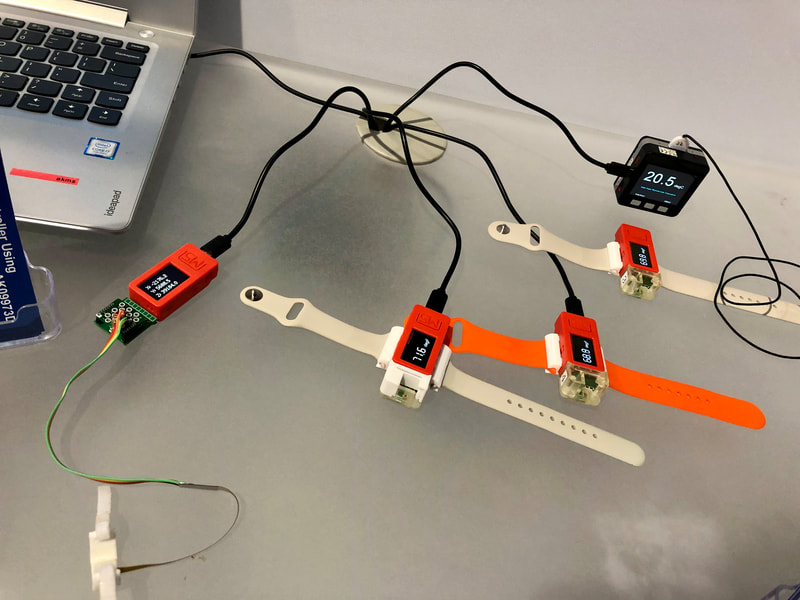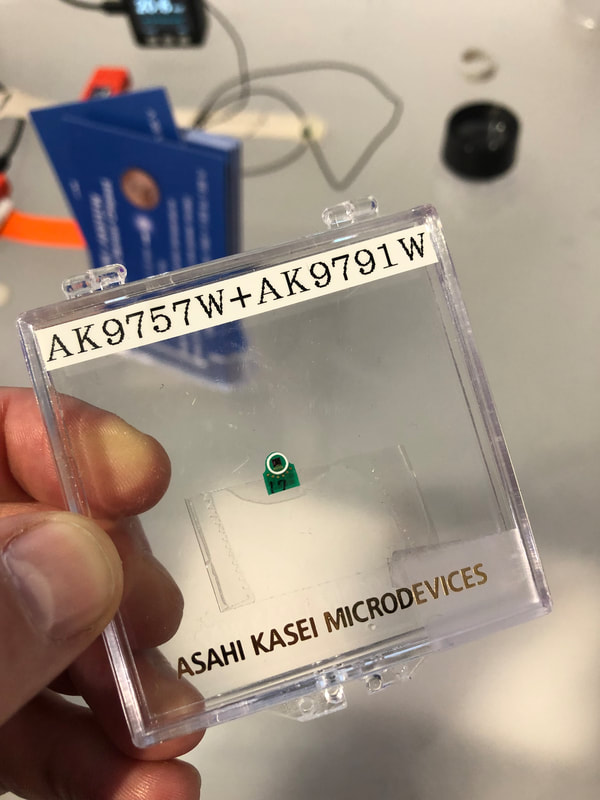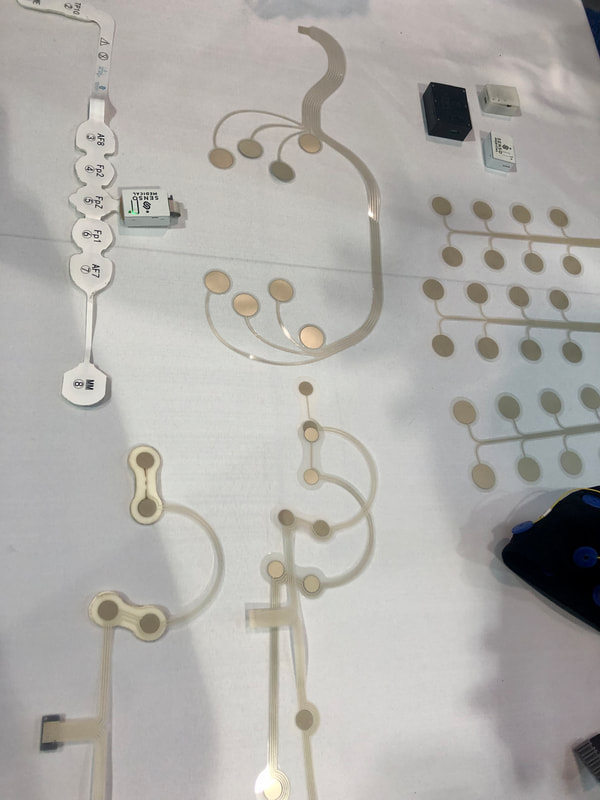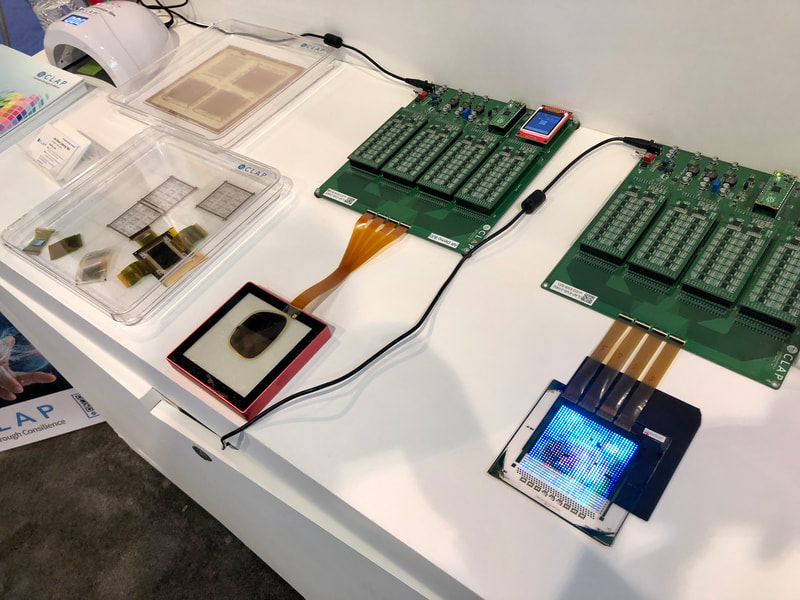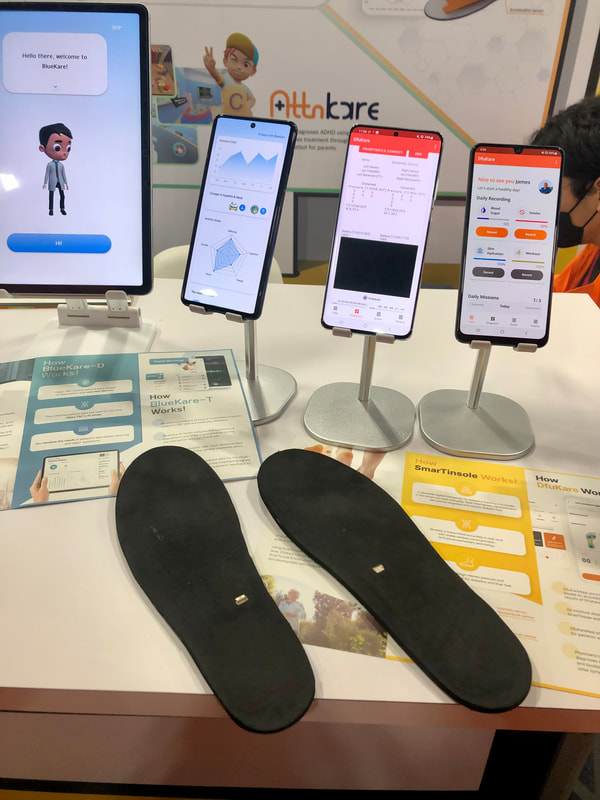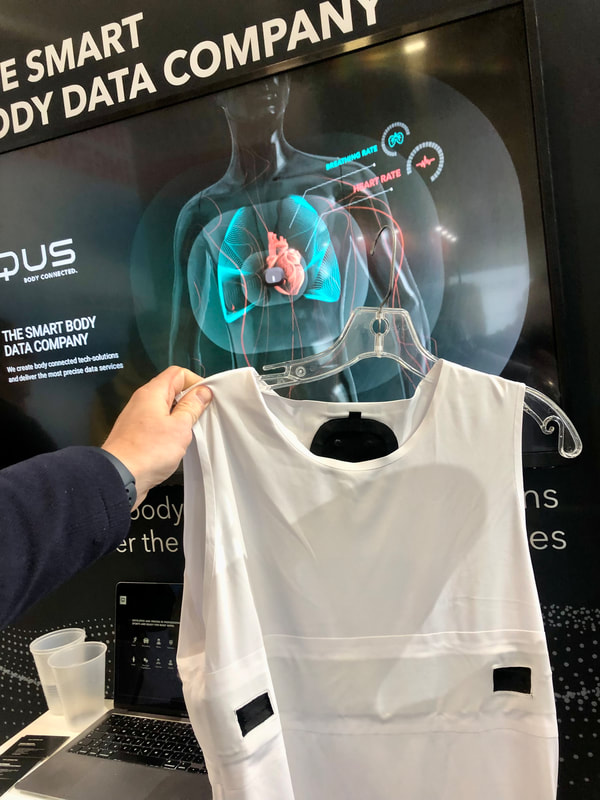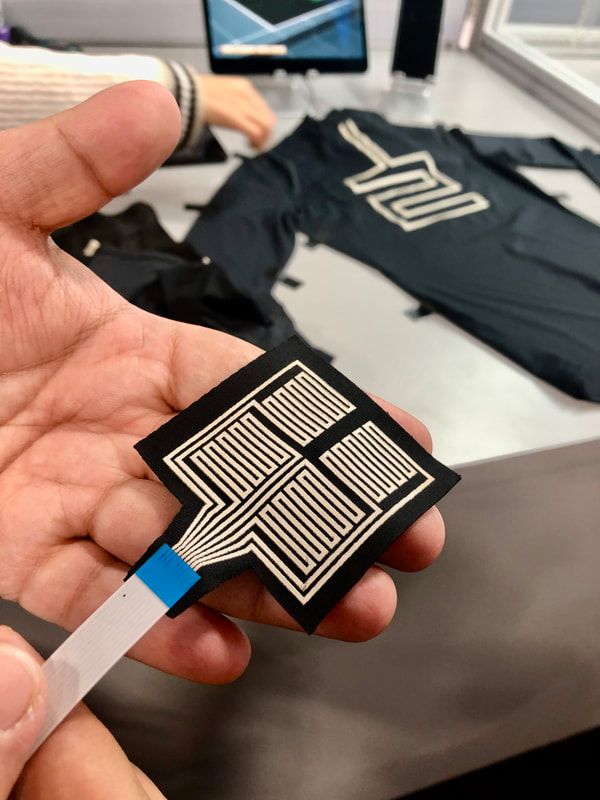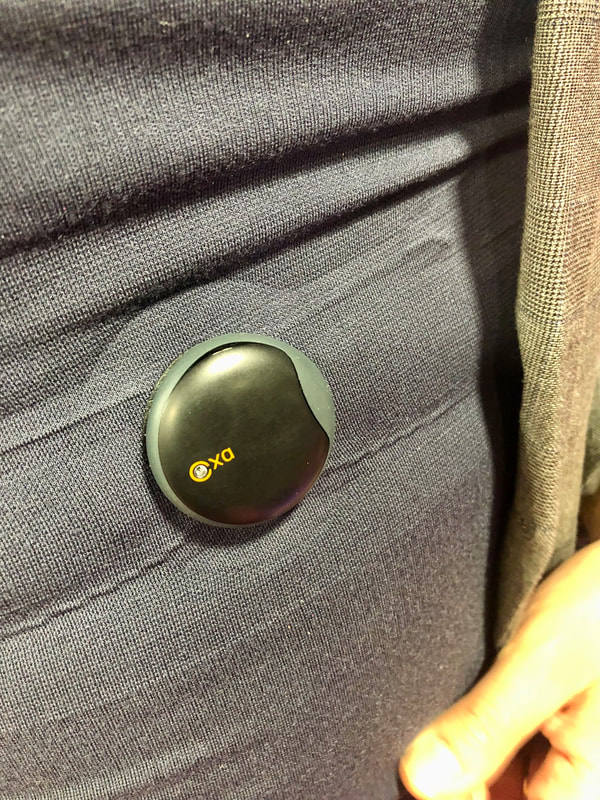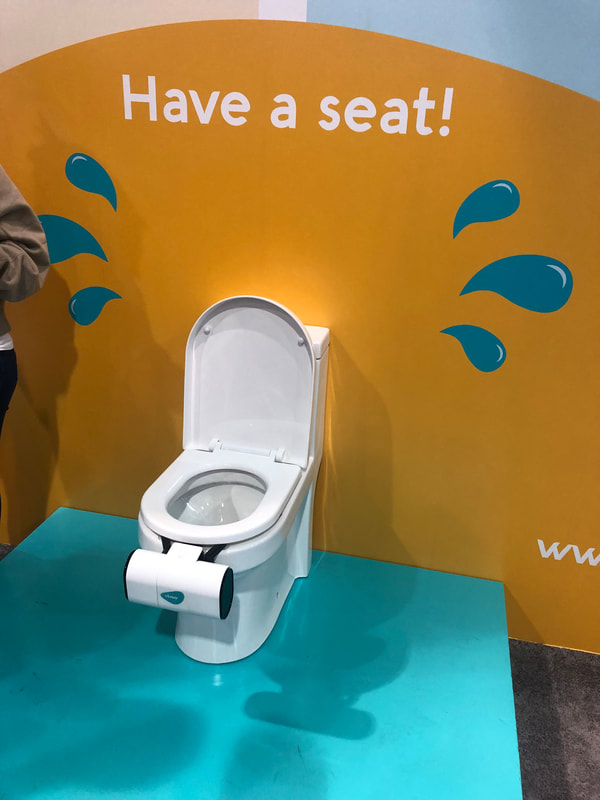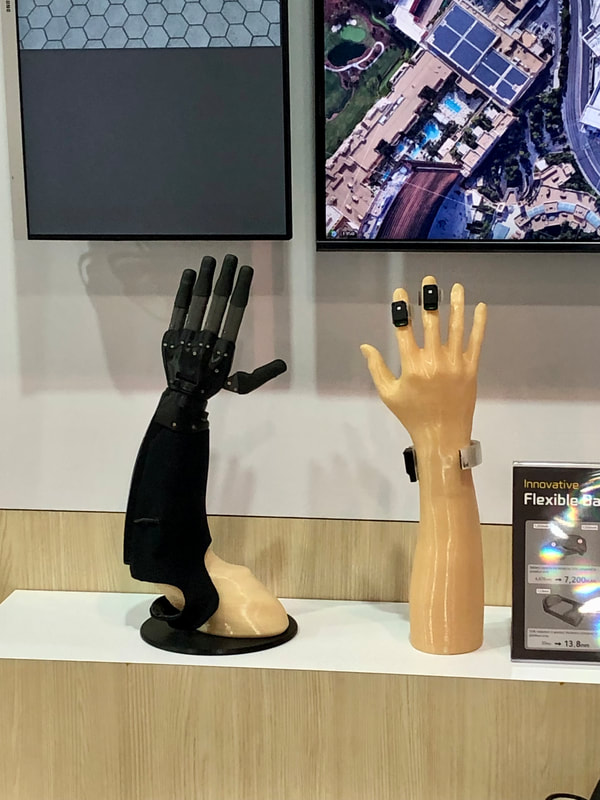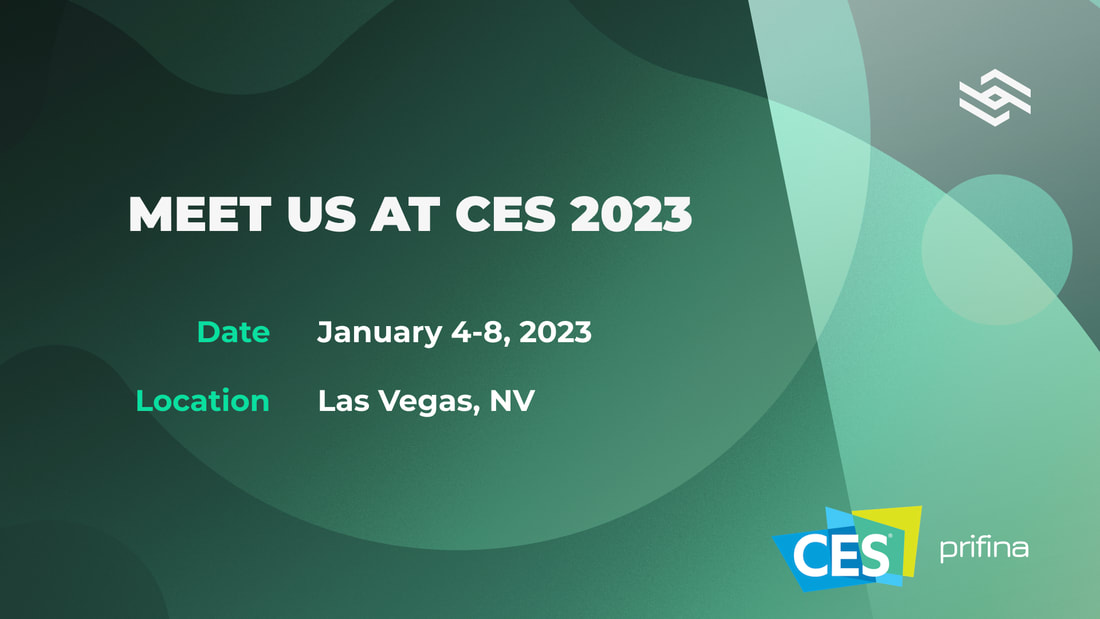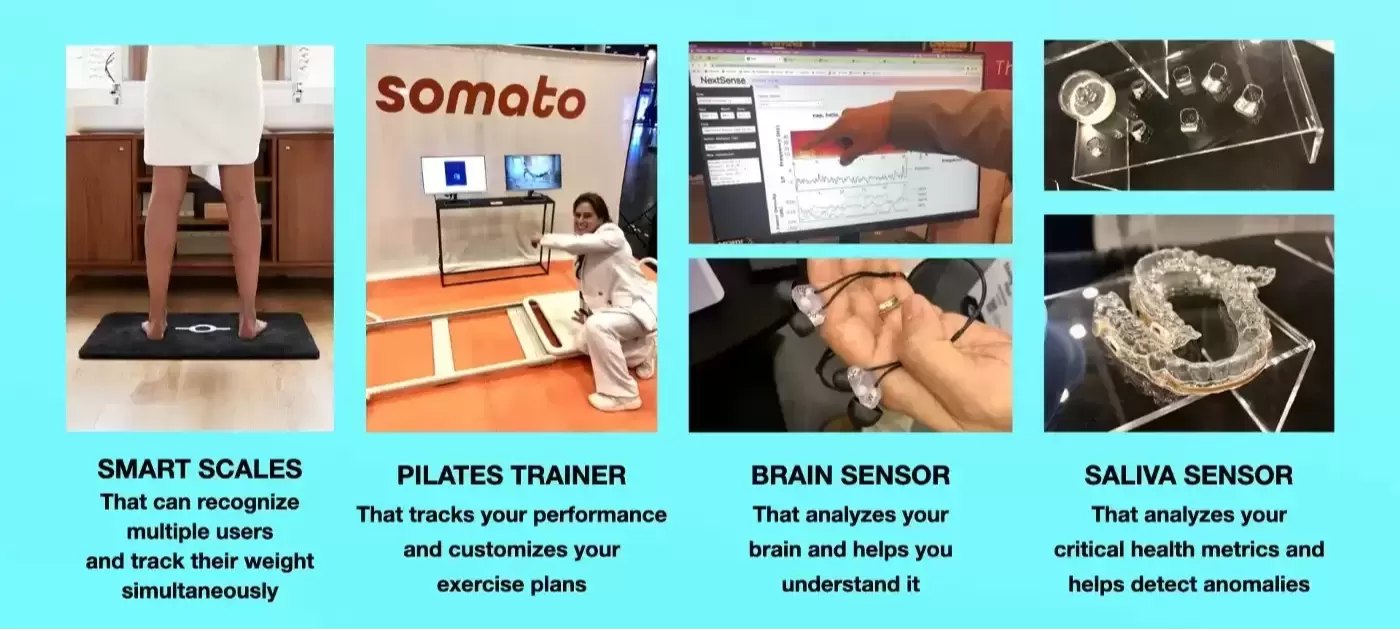|
Prifina’s CEO Markus Lampinen spoke to Alex Bond on the podcast about the current trends with personal data and how individualized data-driven innovation could be introduced to the insurance services market. TLDR
Markus: My name is Markus Lampinen, I'm based in San Francisco where I run a company Prifina. We help make products smart. We do this by embedding sensors into different types of physical products. For example, I'm wearing - not that you can see it on the podcast - a really nice kimono-based silk jacket produced by a Tokyo-based company Ichijiku. This jacket has an embedded sensor that can measure a number of different things around, e.g., how the jacket is doing, surrounding data like humidity, etc. Our role at Prifina is to overlay different types of datasets like the sensor data and correlating them with other types of data, e.g., your heart rate when you wear the jacket. Prifina allows companies to build different types of applications that enable them reimagine the end-user experience for how we interact with not only physical products but data. Our vision is that in the future, have more data than ever - how can we use it to create new experiences? Something that's different from what we've had? Alex: That's great. I think that when people hear about sensor-driven technology in clothing, they think about performance, sportswear. But it's much more than that, isn't it? Markus: That's right. We work with pro athletes that want to improve their performance, e.g., top basketball clubs. For them, it's about understanding performance, recovery, sleep, stress, hormonal activities, and so on. From a player’s point of view, how can players themselves understand what's going on with their body and their environment to essentially get better? But it's not just about performance sports, it's also about stress - how do you manage stress? There is a lot of data that we already have, e.g., our sleep data. We can go all the way to, for example, luxury fashion and thinking about how does the clothing that you wear impact your your mood or happiness? As for all this data, we're kind of sitting on this goldmine: we, individuals, have so much data but we're just not using it. It's a huge opportunity. With user-generated data, it is possible to build new types of experiences. Alex: We're now talking at the MENA Insurance Summit. How does this relate to, for example, insurers? Markus: We work with a lot of insurance companies around the world are looking look at preventative health, mental health and wellness. If you can make your policyholders healthier and happier, then they're going to be better customers for the insurance company, because they have very similar incentives as the insurance company does. Alex: Okay, applications are really wide for the insurance industry. … Markus, you explained that it's not just about kind of tracking the data, but it is about the lifetime value of a product that is enhanced by your own data. Markus Lampinen: Indeed, the lifetime value is one important aspect of a product. How are you maintaining your car? Are you driving it too fast, and so on and so forth. But then, we get into this very delicate balance as well: the data should benefit you as an individual, not the insurance company alone. At the end of the day, for example, when it comes to different types of collectibles, tracing the entire value chain (where everything came from, who actually owns it, etc.) becomes important, especially for maintaining the value and also secondary transactions. This fits into a broader conversation about what is authentic, especially in the digital environments powered by applied AI and deep fakes. We have Barack Obama thats now trying to sell you some skin care product. How do you know that something is authentic? But our focus is very much on reimagining the whole of the consumer experience using data. There are incredible applications as we move forward. For example, cars generate a lot of data. So do you as an individual. What if you could just enter into the car which already knows that, am I a five star driver today? Or that I am only a three star driver today? If you slept really poorly of if you had a little bit more than one drink…? We're not talking about sharing it anywhere, but using your own data for your own benefit. That’s where there's this interplay between all the data that we have and all the things around us. How can we tie them into a unique importable experience going forward? It's a very, very big theme, of course, but that's kind of something that we look at as an inevitable trend. Alex Bond: I think people are just starting to wake up to be protective of that. I’d like to finish with one more question: what does it mean for insurance? I'm an insurance guy. What about applications for the insurance sector? Markus Lampinen: Sure. Insurance emerged as a very clear secondary market for personal data use-cases. Let's take an example. After today’s summit here in Doha, I'm traveling to Switzerland where we're working with our partner that has a sensor embedded into both the left and the right ski boot as well as the helmet. So you can actually get your triangulate the skier and their position to maybe help them improve. Now, performance athletes may care about the angle of tilt on their 760 turn on the mountain. But most skiers don't. But if you start essentially hitting this type of data on skiers, could you create individualized insurance per skier per day in dynamic conditions? Could you give them incentives to ski safer based on those? These are some things that are currently really hard to price dynamically. But if you started having this type of data, could he actually create almost like reverse marketplaces for these types of products? Could you do this on, let's say, a resort by resort basis? You can also use it as, let's say recommendations for routes on different types of ski resorts. You can also use it for insurance products as well. So that's been very much our foray into thinking about starting off in a very, very clear value prop for the individual, but then realizing that there's this entire ecosystem. Alex Bond: Markus, you've been very generous with your time. Thanks for being a guest. You find the entire conversation on , here it is.
1 Comment
Elevating Luxury Fashion: Prifina and Ichijiku's Sensorized Jackets Redefine Customer Experiences5/25/2023 San Francisco-based tech company Prifina and Tokyo-based luxury fashion brand Ichijiku are pleased to announce a groundbreaking partnership that aims to fuse the worlds of fashion and technology. With a shared vision of innovation and a passion for creating unique experiences, Prifina and Ichijiku are set to revolutionize the luxury fashion industry. Ichijiku, renowned for its exquisite craftsmanship and commitment to preserving kimono history and culture, specializes in one-of-a-kind apparel and fashion accessories made from the highest quality authentic kimono fabric. By blending traditional elements with modern designs, Ichijiku has established itself as a global symbol of elegance and luxury. In their quest to push the boundaries of fashion, Ichijiku has chosen to collaborate with Prifina to embark on an exciting new venture: sensorized jackets. These innovative garments will be embedded with cutting-edge sensors, enabling wearers to enjoy a truly immersive digital experience. By measuring variables such as light, humidity, and temperature these sensorized jackets will provide wearers with real-time data about their surroundings. This data can be utilized for myriad purposes, including allowing the owner to ensure the jackets are maintained in ideal conditions. Last week, the Prifina team had the privilege of visiting Ichijiku's headquarters in Tokyo, where they met with the passionate and forward-thinking team behind the brand. Over a series of meetings and a delightful lunch, ideas were exchanged, and the groundwork for this transformative partnership was laid. Ichijiku's ambitious plan involves integrating sensors into all their jackets, expanding their offering beyond visual aesthetics to include a dynamic and interactive element. With the ability to collect and analyze environmental data, wearers will gain insights into their surroundings, allowing them to make informed decisions about their well-being and comfort. In return, Prifina will extend a warm welcome to the Ichijiku team in mid-July, inviting them to their headquarters in San Francisco. This exchange of knowledge, expertise, and cultural influences will undoubtedly fuel collaborative efforts, leading to groundbreaking advancements in the fashion-tech industry. The partnership between Prifina and Ichijiku represents a significant step toward the future of luxury fashion. By embracing technology and incorporating it seamlessly into its designs, Ichijiku is poised to redefine how we experience and interact with fashion. Through this collaboration, both companies are committed to pushing boundaries, breaking norms, and creating a new era where fashion and technology intertwine harmoniously. As fashion continues to evolve, this exciting venture signifies the importance of embracing innovation to cater to the ever-changing demands of consumers. Prifina and Ichijiku's partnership represents a fusion of expertise, creativity, and a shared commitment to pushing the boundaries of what is possible. Together, they are set to revolutionize the luxury fashion industry and pave the way for a new era of sensorized fashion experiences.
Stay tuned as Prifina and Ichijiku work tirelessly to bring their sensorized jackets to life. The future of luxury fashion is here, and it's poised to be an extraordinary blend of tradition, innovation, and limitless possibilities. In the heart of Bern, Switzerland, an innovation and future conference - The 2291 Festival - recently provided a platform for Prifina to showcase its remarkable progress in collaboration with its Swiss partner companies. This event brought together visionaries, industry leaders, and venture capital firms, highlighting the transformative potential in the areas of sensors, personal data and AI. Prifina, along with Heierling, known for their high-end ski boots and equipment, took center stage at the event. We unveiled next-generation of ski boots and helmets that collect skiing data and seamlessly integrate it into their personal data cloud provided by Prifina. Users can then access applications that leverage this data, such as an AI ski coach, providing personalized insights and recommendations. Markus Lampinen and Jouko Ahvenainen took the stage to deliver thought-provoking talks during the event. Their focus centered on the fundamental question of personal data ownership and control, emphasizing that it is not only about owning the data but also enabling ordinary individuals to access applications built on their personal data. “Empowerment with personal data is crucial for individuals to lead healthier and more fulfilling lives.” - Jouko Ahvenainen Prifina's current primary focus revolves around leveraging data and applications to enhance people's well-being based on health and wearable data. By harnessing the power of personal data, Prifina aims to provide individuals with the tools they need to lead healthier lifestyles and make informed decisions about their well-being. Throughout the event, there were compelling discussions on the role of innovation in improving the lives of people. It was acknowledged that while technological advancements have the potential to revolutionize various aspects of our lives, there are also concerns about how companies and governments may misuse personal data for control. In this context, the consensus was that giving individuals better control over their personal data can empower them to lead better, healthier lives. Switzerland, known for its commitment to individual freedom and empowerment, has always held personal data control in high regard. The Swiss people recognize the importance of safeguarding personal data and ensuring that individuals retain the rights to make decisions regarding their own information. It is this shared belief that has facilitated a fruitful collaboration between Prifina, Heierling and Code Fabric, as they work together to redefine personal data ownership and control.
Prifina’s collaborations with Swiss companies shows the immense potential with user-generated personal data. By combining our expertise in technology, skiing equipment, and personal data management, we are pushing the boundaries of what is possible. This represents a unique opportunity for other consumer brands seeking innovative approaches to their product offering that have a positive impact on people's lives. Our general takeaway is that the future with user-generated personal data looks promising. Our vision of empowering individuals through personal data control resonates strongly with the Swiss people and the global community at large. Stay tuned for more updates as Prifina strives to revolutionize the way we experience sports and personal data, ultimately enhancing our lives in ways we never thought possible. On May 3rd, 2023, the Prifina team with its co-organizers at New York Life, hosted a panel on how AI-driven innovation and advances will impact consumer experiences. The event was sold out and we thank all attendees who braved the spontaneous rain in San Francisco to join in person. We’re grateful for such lively audience participation and brilliant questions for our panel, which included Mickey McManus, BCG, Malavica Sridhar, Founder, Northstarre, Markus Lampinen, Co-Founder and CEO, Prifina and moderator Amber Wang, Women in AI / Cerebral Valley. The panelists together raised various observations and addressed the trends in the current market:
With such a boom in generative AI, personal data and private use of personal data become fundamentally important. Not only because of privacy concerns but also because of representation; if apps and services are built utilizing individual models that represent the users, we can truly deliver private AI that helps us achieve what we want in life. Like an audience member asked: which human activities should we trust to AI and which should we want to perform ourselves? Questions like these are at the very heart of the debate, but should it not be our choice as individuals based on our preferences? After all, studies show that outsourcing tasks and chores you do not wish to do increases your overall satisfaction in your life. Thank you all for the wonderful debate and we cannot wait to see you soon to showcase more of what Personal AI can deliver, privately, to each of us. Imagine you have your own Personal AI assistant that can help you get any answer about yourself - your wellness and well-being, your health, or your daily routines - and those answers are based on real data from the fitness devices and apps that you use everyday day, what would you ask? If such an opportunity to better understand your daily metrics arrives, why would you choose not to have your own Personal AI assistant? For years, consumer brands have tried to create products that give us the inner feeling of freedom, empowerment, and happiness. How have brands adapted to rapid technological change, and what will the consumer experience look like in the age of AI? Image credit: Levi's Strauss. Denim as a Decadent Symbol of Liberty Let’s travel back in time. During the Cold War, jeans were considered a symbol of capitalism. Denim was banned behind the iron curtain and jeans-wearers were enemies of the communist state. International fashion trends, however, could not be stopped at the iron curtain, and Levi’s jeans have become the most sought-after item for the youth in the East: a part of the West many of them dreamed to obtain. One of the most famous commercials of all time was Levi’s advertisement “1984 Russia.” It told a story of a young man returning from abroad to a Soviet airport. The security personnel opened his suitcase to check for any illegal goods, but they are momentarily distracted and the man returns home with his most prized possession. The traveler would risk everything for his Levi’s. When Everything Changed It seems that the year 1984 changed the world as we know it: it was the year when Apple introduced Macintosh. The ad responded to the fear of those days when people were surveilled by Big Brother, and offered the hope that the new Mac would actually “set people free”: Several decades later, Apple’s executives still refer to that early concept of Mac and reiterate, that the information we as individuals create by using Apple’s products belongs to us and that by using Apple’s products we will be happier every day. Reinventing Denim with Sensors Fast-forward to 2018 when Google and Levi's have teamed up to create a new - sensorized - version of the iconic Trucker Jacket, which featured Google's Jacquard technology. This technology allowed the wearer to interact with their smartphone through touch-sensitive areas on the jacket's sleeve. The jacket has a range of functions, including the ability to control music playback, answer calls and get directions, all without needing to take out the phone. The collaboration between the Google and Levi’s aimed to create a wearable that seamlessly integrates technology into everyday clothing. The new Trucker Jacket is a step towards creating more intuitive and functional wearable technology that can enhance people's lives and make the use of technology more seamless. 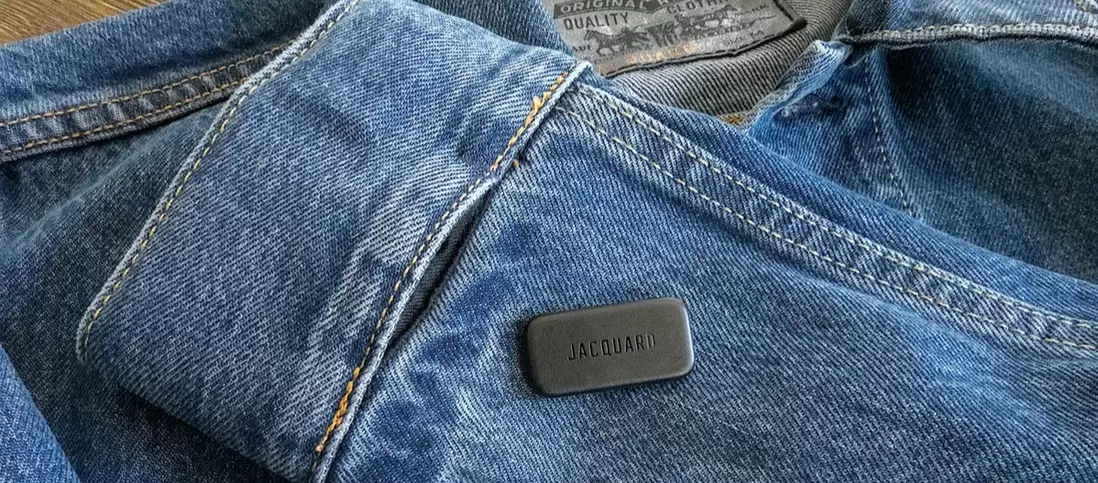 Customer Engagement in the Age of AI The concept of creating personal AI assistants is not new, but the currently available voice assistants in the market have limited utility. This could be due to the fact that Siris and Alexas are based on limited data which users generate using specific companies’ products and services. With so much data that each of us generates, it is necessary to rethink the architecture of how personal data is aggregated and used. Individuals need to have all of their data - not just data from a device or one app - on their side. Then, we can expect AI assistants to actually empower consumers. One of the key lessons that ChatGPT taught us is seamless user experience and the availability of easy-to-use tools for any individual. When it comes to our personal life, sensorized devices and services we use in our daily personal lives, AI assistants must be tools available at your fingertips. Personal AI assistants of the future must allow us to ask anything about myself, about things that matter to us Similar to how the denim movement could not be stopped in the 1980s, AI's development is not asking for permission, whatever technology and data leaders may presume. The question is how we develop it and what type of incentives we give our AIs. At Prifina, we strongly believe that individuals should be represented by their own AI that runs on individuals side, advocates for them and works for them. However, data-driven insights are not the only components of a digital customer experience. Brands should continue exploring possible ways to increase brand value for customers and find new modalities for emotional engagement with the product. We have an opportunity to not only be empowered by the jeans we wear but also personalized applications that help us reach the goals we set in our lives. The possibilities are endless, and we are excited to be at the forefront of this technology. By Paul Jurcys If you could ask your personal AI assistant anything about your personal life what would you ask? What would you like to know about yourself based on your own data? Based on my current level of restfulness, if I want to have a productive day tomorrow, how should I prepare for it? Based on my data about this week’s exercise records and routines, what improvements can I make to increase my performance next week? The current ChatGPT boom has spawned many new generative and general intelligence startups utilizing different large language models. These models are trained on public data sources and can answer various questions based on this training data set. However, they have limitations as it comes to answering more personal questions and with privacy concerns, there are opportunities to build new AI models on personal data frameworks like Prifina’s user-held data model. In this post, we explore how personal applications and “AI” solutions can be realized on a more individualized basis. Can Everyone Train Their Own AI? We are at the turning point where the human-centric technology ecosystem becomes real and individuals actually control their own data. Federated cloud architecture and edge computing technologies have now matured to empower individuals with their data. Prifina’s human-centric data model refers to a data infrastructure that is built around an individual consumer who can collect data from various personal data sources in real-time and have actual ownership and control of such data. This human-centric approach to personal data is built on the principle that an individual’s personal data should be private by default and not shared with anyone unless the user decides otherwise. The idea of individuals owning their data is not new. In the early days of the internet, entrepreneurs working at up-and-coming companies thought that user’s data should belong to them. Being able to access, collect and own your personal data from different sources is the major condition for individuals to train their personal AI. Prifina's User-Held Data Ecosystem Prifina’s user-held data platform has two distinct features. First, each individual user has their personal data cloud where they can collect data from various data sources: personal sensors, wearables such as smart watches, fitness or sleep trackers, and online data sources (e.g., the location from Google Maps, Amazon shopping history, activity while using social media services, apps, etc.). In Prifina’s ecosystem, each personal data cloud has an embedded software robot that unifies the data regardless of the format it comes to the personal data cloud. Second, developers and companies can use Prifina’s open-source tools to build new applications that “come to the user” and run locally (i.e., “on top of” user-held data). Instead of sending data to centralized siloed environments of iOS or Android or any other company providing a sensorized device, individuals in Prifina’s user-held data environment can benefit from full ownership and control: personal data is private by default. Prifina’s user-held data model opens new opportunities with personal data: developers can easily build apps without having to solve complex data (back-end) problems. Prifina’s approach to personal data frees developers from the hefty burden of complying with data privacy regulations because apps run locally (“on top of” user-held data) and generate value from personal data on the user’s side (instead of being centralized in a service provider’s platform). Understanding Your Data with Personal AI If you think about your own personal data - data from your personal fitness trackers, smart watches, personal IoT devices at home, and all apps on your phone - are you actually able to benefit from all the data you have generated over the years? At Prifina, we start from the premise that each individual should have a master copy of their data. In our user-held data ecosystem, individuals can connect all their data sources and create their own personal data hubs. Once you have all your personal data in one place (your personal data cloud), you can start exploring it: your personal AI assistant will answer questions about your own personal data (not random public data that has no relevance to you). For example, you can ask your Personal AI assistant how well you slept last night, or after finishing your daily morning exercise, you can ask your personal AI assistant about your performance today and what circumstances during the past few weeks contribute to better or work physical condition. Here are some more specific examples of Personal AI assistants that We at Prifina built to empower individuals with their own personal data: Example #1: My personal avatar At Prifina, we built a personal avatar that takes into account data from an individual's personal fitness devices and, based on various biomarkers, appears differently. So, if you were staying well hydrated, got enough sleep and also managed to exercise, your avatar appears fit and energetic. However, If you worked long hours today and did not have enough rest last night, the avatar will appear sluggish and unhappy. You can also interact with your personal avatar and ask: “what is my readiness level now?” “How can I improve my productivity today?” The avatar will give you a response based on your own personal, and if relevant, some public data (e.g., weather conditions during your recent activity, etc.). Example #2: My Data Diary Imagine if you could connect multiple data sources to your daily calendar: your wearable fitness devices, sleep trackers, home IoT devices and your online accounts (such as Spotify or Netflix, etc.) and that you talk to your data diary, what would you ask? For instance, you could ask your data diary about your readiness level before and after the meeting, or how focused you were before the meeting. Based on your wearables and other data, you could also ask your personal data diary about the music or surrounding circumstances that make your day more productive, wouldn’t that be great? What else would you like to explore with your intelligent data diary? Empowering Developers: Liberty. Equality. Data. Prifina’s open developer platform empowers developers to build applications that can correlate different data sources - both private and public. At Prifina, we are gradually releasing resources for developers to build on top of user-held data and to integrate various machine-learning tools into apps. These tools help developers and brands build applications to help individuals get adily value from their data - to interact with their data and ask anything. Consider all possible use cases where individuals could benefit from their personal data: health and wellbeing, emotional state, connected home and offices, optimizing daily routines, and so on. In Prifina’s personal data infrastructure, personal AI tools can be embedded in any application. Such personal AI assistants could take different forms: a simple chat window or voice-to-text where you can ask your personal AI any question and get an answer based on your personal data and publicly available data.
Most importantly, Prifina’s user-held data model ensures the privacy and safety of personal data because every user’s data is private by default. Welcome to the human-centric data ecosystem, powered by Prifina! In the past few years, we have witnessed many signs of rapid climate change. Droughts, extreme heat and cold, hurricanes, and wildfires are happening more frequently. Also, in November 2022, the global population surpassed eight billion people. In this post, we explore new possibilities to unlock the value of “green data” to help people adopt green lifestyles, make cities more sustainable, and facilitate the proliferation of green innovation ecosystems. We are optimistic that Prifina’s user-held data model could pave the way for data-driven solutions and improve the general well-being of individuals as well as local and global communities. Three Scenarios
New Businesses and Data Models to Tackle Climate Change Some of the biggest Silicon Valley companies, led by Stripe, have launched a 1 billion US Dollar fund that aims to provide advance funding for companies working on carbon capture technologies to help build the market for carbon capture. The idea here is to provide enough capital for startups that develop solutions to remove carbon from the air and safely store it underground for a thousand years. These technologies already exist, so visionary climate tech investors are trying to help scale the development of such technologies. From the data technologies perspective, we can see how fast cloud computing, machine learning, and edge computing models are advancing: devices have more sensors and data processing capabilities are becoming more powerful. Based on our consumer research, the Prifina team knows that:
Prifina has built a data platform for individuals where the user's data is private by default. With Prifina, an individual consumer can collect data from various personal data sources in real time (e.g., personal wearable devices, sensors from IoT gadgets at home, and online accounts). In Prifina’s environment, individuals do not have to give away data to every service provider they interact with; third-party applications come to the user and run on top of user-held data. A user-held data model opens new opportunities with personal data: developers can easily build applications without solving complex data (backend) problems. From a legal point of view, Prifina’s user-centric, user-held data architecture goes beyond privacy-by-design principles: in Prifina’s model, the user’s data is private by default (not shared with anyone). Empowering Individuals with "Green" Data If people are conscious about their carbon footprint, is there any way to empower them to make better daily choices and facilitate more “green lifestyles”? The user-held data model combined with insights from behavioral science about nudges and disclosures could help spur innovation in this domain. For example, we are all accustomed to seeing food labels that disclose various information about the products we are buying, how much sugar, fat, carbs, and calories they contain. It is up to every consumer to decide if they want to read the label. But making the information available is a big step forward in helping people make informed choices about the food they buy. Two years ago, Apple introduced “privacy labels” - similar types of disclosures about how applications use our data (what categories of data apps collect, and how this data is used). Many of us may not check this information before downloading apps, but it helps app users to check if they are “happy” with how their data is accessed, collected and used. Similar examples of disclosures could be found in mobility services. For instance, some airlines are giving options to purchase more expensive tickets and subsidize the use of less polluting diesel during the flight. If we think about personal IoT data, what kinds of applications could be created to provide insights based on personal sensors? One of the major benefits of the user-held data model is that it allows the building of new types of applications that can correlate data from various data sources of an individual user.
With Prifina, developers can build a “My Carbon Footprint” app that correlates data from user’s location data from Google Maps and Apple Maps, how often the user uses public transport (bus, train, taxi), how often a user is cycling and driving his own car, and how often he travels by plane. A “My Carbon Footprint” app of this kind could simply show correlations between different data points, and help people better understand their daily/monthly carbon footprint. Such an app can also include additional personalized insights that make end-users more aware and responsible for their environmentally affecting actions. Similar applications could be built on user-held data about using energy at home (e.g., how much energy is consumed in total, what percentage of energy is coming from renewable sources, and offer recommendations on whether certain heating/cooling IoT devices could be more energy-efficient). Additional insights could be created by app developers who correlate data from different categories of data sources (e.g., how outdoor exercise activities decrease/increase energy consumption at home). Making Cities Smart and Green Current smart city solutions are based on one premise: the need to collect lots of data in various public settings (streets, highways, parking lots, etc.) utilizing various sensors (e.g., parking meters) and surveillance tools (e.g., video cameras and facial recognition technologies). To collect such data, authorities engage with many private vendors who are entrusted with complex tasks to manage networks, infrastructure, and big data. Data is at the heart of many smart-city interactions: optimizing traffic and public transport, distributing energy consumption, power and water supply, waste management, crime control, healthcare, and community services. All these directly impact the environment: improving air quality, waste of food and energy, noise pollution and designing responses to climate disasters. At the same time, holding sensitive data is becoming a privacy liability for both public and private organizations. As a result, many public and private entities are simply unable to leverage significant personal data centrally and decide whether they want to limit data collection or find another way utilizing data. Prifina’s user-held data model could be beneficial in developing more citizen or human-centric solutions. For example, user-generated mobility data from smart wearables could be combined with public data (e.g., weather and air quality data) to offer individuals healthier walking routes. Similarly, public and user-generated energy consumption data could be utilized to better manage energy distribution during peak hours. In a post-Covid environment, many applications can be created to increase the utility of idle resources (e.g., unused office spaces, empty parking lots) or use-privacy preserving data access frameworks to build more resilient cities (e.g., manage access to buildings and office spaces without exposing sensitive employee data). Taken as a whole, the combined use of private and public green data could generate more value for society. Green Apps Powered by Private Personal Data To unlock the value of “green data” and empower individuals to adopt green lifestyles, new data access and governance rules should be established. The European Union is taking the lead in this regard: In February 2020, the EU Commission published a European Strategy for Data, laying out its ambition to make the EU the leading role in the global data economy. One of the key EU instruments is the proposed European Data Act which aims to unlock the data currently collected by and harnessed by the manufacturers of IoT devices. After the Data Act comes into effect, individual consumers and business entities using sensorized devices will have the right to access the data which is generated through the use of the device. At Prifina, we support initiatives that promote access to data, transparency and equality in the market. As we look into the future, we believe that the human-centric approach to data discussed above helps to find new ways to activate “green data” and create “green value” by utilizing user-generated data. This year, from January 4th to 8th, the largest event of the year, the Consumer Electronics Show (CES), took place in Las Vegas, where more than three thousand companies from all over the world presented their latest technologies. In this post, we share our insights about the main trends in electronics based on what we saw at CES this year. CES 2023 In January 2023, more than a hundred thousand participants gathered at CES to witness what’s hot in the consumer electronics market. The Prifina team, together with other technology innovators, representatives of large and small companies from all over the world, government officials and private capital investors spent four days navigating huge convention halls and testing the latest gadgets and technologies. Many countries had pavilions, but South Korea, Taiwan, Japan, and France appeared to have the most representatives at CES 2023. As expected, CES conference halls were lit by unprecedented size screens showcased by suchLG, Sony and other companies. Automobile companies introduced their new-futuristic-autonomous-electric car models. Also, it was possible to witness how fast robotics technology is developing (e.g., one company showcased a robotic arm capable of performing dental implant operations). One of the largest beverage companies from Japan, Suntory, introduced new technologies allowing one to insert a 3D shape into a drink that remains unchanged until it touches lips. John Deere brought an impressive tractor that appeared to have two wings, each of which had eighteen cameras that could distinguish crops from weeds and spray pesticides only in the places where the weeds grow (est. price ca. $800,000). After having spent four days among thousands of tech companies, we, the Prifina team, have identified three main trends: (a) sensors are coming to every aspect of our daily lives, (b) all devices that we will use will be sensorized, and (c) new types of AI assistants are emerging to empower individuals in various daily situations. Trend 1: Sensors Everywhere The first trend is that sensors are entering every aspect of our lives. In fact, out of 3200+ technology companies, more than half had something to do with sensors - most of the exhibitors were in the Internet of Things (IoT) and artificial intelligence (AI) categories. At CES, we saw many companies from around the world that produce the most diverse sensors for various consumer and enterprise applications. For example, the Dutch company Mantiscope presented a sensor that measures liquid content. This sensor, which is just a few millimeters in size, can detect the content of a person's sweat or other liquid (such as wine). South Korea had a separate pavilion where several dozen companies presented semiconductors, paper-thin flexible screens, and millimeter-sized sensors. This excellent stand reflects the South Korean government's plan to invest $500 billion in the semiconductor sector by 2030. Trend 2: Sensorized Products Nowadays, the prices of electronic sensors are so low that almost all consumer products presented at CES are sensorized. In other words, it is now clear that sensors are coming into every object and device we use daily; each of us will generate more and more data. Such user-generated data will help us make better decisions in the most diverse life situations. For example, sensors are already being integrated into materials and clothing that collect diverse biometric data - body temperature, heart rate, distance walked - and the environmental factors around us, and the location of a human or a sensorized product. Such sensorized products will soon appear everywhere - in fashion and exercise clothing, home appliances, workplaces, and public spaces. At CES, it was also possible to see how quickly sensors and their accompanying applications are improving: consumer sensorized products (e.g., smart watches, smart rings, etc.) have integrated sensors whose accuracy is almost equivalent to medical devices used in hospitals. Competition in sensorized product markets is also heating up - during CES, there were multiple sensorized products created for every life situation. Each sensorized product also has an application that presents certain results generated based on data collected by sensors. Often such sensorized product apps also have integrated artificial intelligence prediction models that can not only show data about a specific factual situation but also make predictions and possible future trends (e.g., how the health will evolve) and recommendations on how a person can adjust the behavior. Trend 3: Empowering Consumers With Data
With the increasing amount of consumer data, it is important to figure out how such data could be used to empower consumers in their daily lives. We witnessed that most companies showcasing at CES understand the need to create certain algorithms that create additional value from data generated by sensors. Many companies at the CES are creating AI solutions for specific real-life problems. Many of them were concentrated in the health-tech sector, where medical-grade sensors are implemented in consumer products that are tailored for remote patient monitoring. Such breakthroughs in artificial intelligence, machine learning, and cloud computing open opportunities to create new applications of these technologies. At Prifina, we see that two separate consumer-grade and medical-grade product categories will merge in the near future. At Prifina, we also see that the real challenge - and the opportunity - is to build products and ecosystems centered around individuals. This will lead to better customer experience, deeper engagement with sensorized products, and the next era of personalization, which will be based on personal data. Paths Forward The Prifina team made a lot of meaningful connections with companies from around the world who are eager to explore Prifina’s personal data platform to improve their products by connecting more data sources. Adding new sensors to products around us allows us to create new experiences, such as quantifying confidence with different clothing or analyzing dehydration during exercise to optimize hydration and recovery. We are excited about this coming year and will keep you updated about some of the fascinating use cases we are working on. More about CES from the Prifina Team: Embedding Sensors for Personal UseThe Consumer Electronics Summit will once again take place on January 5 to 8, 2023 in Las Vegas, Nevada and is expected to feature over 100,000 attendees over the course of a few days. The event will feature consumer electronics, sensors and different innovation in technology and consumer goods. Last year CES featured many sensorized products and we also wrote a recap from last year's event which can be found here. Empowering Brands with Out of the Box Data PipelineAt Prifina, we specialize in providing a personal data infrastructure and platform, allowing individuals to connect, collect and unlock value from their own data to create more meaningful experiences. Prifina makes it easy for consumer companies to add sensors and eliminates costs related to building a stand-alone data infrastructure. In Prifina's platform, the user owns the data; and Prifina makes it easier for the brands to build services and apps on user-held data. With Prifina, partner companies can find new opportunities to empower their customers by collaborating with us to embed a sensor into their products. As a result, individual customers can get an elevated experience utilizing data from the newly embedded sensors. Sensor data can also be combined with other personal data sources in the individual's Prifina account, such as sleep, activity, stress data from wearables such as FitBit, Oura ring or ambient data such as pollution, temperature or noise. Expectations for New Products at CESBased on trends in the market, we expect to see the following things at CES 2023:
Start Easy, Start PrivateThe Prifina team is excited to be on the ground at CES and explore new partnerships with companies that are pioneers in various domains of sensorization. Our team specializes in consumer value from sensor data. Together, we can empower individuals with new experiences and services. Connect with us You can connect with the Prifina by emailing paul[at]prifina[dot]com.
We look forward to seeing you at the CES! |
Archives
May 2024
Categories
All
|
Sign up for updates* Prifina will not share it with any third party.
|
The User-Held Data CompanyPrifina is a venture-backed personal data technology company based in San Francisco. Prifina provides a personal data platform that empowers individuals to collect, combine and utilize their personal data to live happier and healthier lives. Consumer brands and developers can build apps and personal AI agents on top of user-held data.
© 2024 Prifina, Inc.
|

